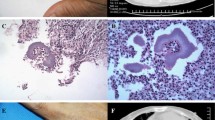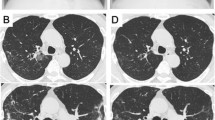Abstract
In the period from 1992 to 2001, 303 cases of nocardioses were diagnosed in Japan, with the corresponding etiological agents isolated and characterized. Taxonomic analyses of these 303 strains showed that most nocardial infections were caused by members of the Nocardia asteroides group (72.3%). Speciation showed that 72 strains were N. asteroides, 31 strains were N. cyriacigeorgica, 2 strains were N. beijingensis, 81 strains were N. farcinica, and 33 strains were N. nova. Sixty-six strains of N. brasiliensis were the next most prevalent species of the total Nocardia isolates, followed by 14 strains of N. otitidiscaviarum. Infections by N. transvalensis(3 strains) and N. pseudobrasiliensis(1 strain) were also confirmed. The infections due to N. transvalensis, N. cyriacigeorgica, and N. beijingensis were the first reported in Japan. The most common factor that predisposed individuals to nocardial infection in Japan was therapy by immunosuppressive agents (22.4%), including SLE therapy (3.6%), followed by cancer (6.6%), diabetes (3.6%) and AIDS (2.0%). Nocardial infections occurred more commonly in the elderly, with most of the patients between the ages of 61 and 80 years of age. No significant difference regarding infectivity levels between the sexes was observed.
Similar content being viewed by others
References
Gordon RE, Barnett DA, Handerhan JE, Pang, CHN. Nocardia coeliaca, Nocardia autotrophica, and the nocardin strain. Int J Syst Bacteriol 197; 24: 54-63.
Goodefellow M. Nocardia and related genera. In: Balows A, Duerden BI (eds), Topley and Wilson's microbiology and microbial infections, 9th edn., vol. 2, Systematic bacteriology. London: Arnold, 1997; pp. 463-489.
Boiron P, Provost F, Chevrier G, Dupont B. Review of nocardial infections in France 1987 to 1990. Eur J Clin Infect Dis 1992; 11: 709-714.
McNeil MM, Brown MJ, Georghiou PR, Allworth AM, Blacklock ZM. Infections due to Nocardia transvalensis: Clinical spectrum and antimicrobial therapy. Clin Infect Dis 1992; 15: 453-463.
Beaman BL, Beaman L. Nocardia species: Host-parasite relationship. Clin Microbiol Rev 1994; 7: 213-264.
Poonwan N, Kusum M, Mikami Y, et al. Pathogenic Nocardia isolated from clinical specimens including those of AIDS patients in Thailand. Eur J Epidemiol 1995; 11: 507-512.
Javaly K, Horowitz HW, Wormser GP. Nocardiosis in patients with human immunodeficiency virus infection. Medicine (Baltimore) 1992; 71: 128-138.
Mirza SH, Campbell C. Mycetoma caused by Nocardia transvalensis. J Clin Pathol 1994; 47: 85-86.
Schaal KP, Lee H-J. Actinomycete infections in humans — a review. Gene 1992; 115: 201-211.
Ruimy R, Riegel P, Carlotti A, et al. Nocardia pseudobrasiliensis sp. nov., a new species of Nocardia which groups bacterial strains previously identified as Nocardia brasiliensis and associated with invasive diseases. Int J Syst Bacteriol 1996; 46: 259-264.
Brown BA, Lopes JO, Wilson RW, et al. Disseminated Nocardia pseudobrasiliensis infection in a patient with AIDS in Brazil. Clin Infect Dis 1999; 28: 144-145.
Wallace RJ, Jr, Brown BA, Blacklock Z, et al. New Nocardia taxon among isolates of Nocardia brasiliensis associated with invasive disease. J Clin Microbiol 1995; 33: 1528-1533.
Pijper A, Pullinger BD. South African nocardiosis. J Trop Med Hyg 1927; 30: 153-156.
Miyashita K, Mikami Y, Arai T. Alkalophilic actinomycetes Nocardiopsis dassonvillei subsp. prasina subsp. nov., isolated from soil. Inter J Syst Bacteriol 1984; 34: 405-409.
Schaal KP. Identification of clinically significant actionomycetes and related bacteria. In: Goodfellow M, Minnikin DE (eds), Chemical methods in bacterial systematics. London: Academic Press, 1985; pp. 359-381.
Mikami Y, Yazawa K. Susceptibility patterns of pathogenic Nocardia to some selected antimicrobial agents and their usefulness in the identification work. Bull Japan Fed Cult Collect 1989; 5: 89-95.
Tamura M, Watanabe K, Mikami Y, Yazawa K, Nishimura K. Molecular characterization of new clinical isolates of Candida albicans and C. dubliniensis in Japan: Analysis reveals a new genotype of C. albicans with group 1 intron. J Clin Microbiol 2001; 39: 4309-4315.
Saitou N, Nei M. The neighbor-joining method: A new method for reconstructing phylogenetic trees. Mol Biol Evol 1987; 4: 406-425.
Thompson JD, Higgins DG, Gibson TJ. CLUSTAL W: Improving the sensitivity of progressive multiple sequence alignment through sequence weighting, position specific gap penalties and weight matrix choice. Nucl Acids Res 1994; 22: 4673-4680.
Shimizu A, Ishikawa O, Nagai Y, Mikami Y, Nishimura K. Primary cutaneous nocardiosis due to Nocardia nova in a healthy woman. Brit J Dermatol 2001; 145: 154-156.
Furumoto H, Sasaki T, Tatebayashi K, Shimizu T, Mikami Y. Profound skin infection with bone involvement due to Nocardia asteroides in a patient with myelodysplastic syndrome. J Dermatol 2001; 28: 582-583.
Maeda M, Aato M, Tozaki Y, Okumura Y, Mikami Y. Nocardia brasiliensis infection seen on grafted skin of the dorsum of a foot. Jap J Med Mycol 2001; 42: 137-142.
Brown JM, McNeil MM, Desmond EP. Nocardia, Rhodococcus, Gordona, Actinomadura, Streptomyces, and other actinomycetes of medical importance. In: Murray PR, Baron EJ, Pfaller MA, Tenover FC, Yolken RH (eds), Manual of clinical microbiology. Washington, DC: American Society for Microbiology, 1999; pp. 370-398.
Wang L, Zhang Y, Lu Z, et al. Nocardia beijingensis sp. nov., a novel isolate from soil. Int J Syst Evol Microbiol 2001; 51: 1783-1788.
Yassin AF, Rainey FA, Steiner U. Nocardia cyriacigeorgici sp. nov. Int J Syst Evol Microbiol 2001; 51: 1419-1423.
Roberts SA, Franklin JC, Mijch A, Spelman D. Nocardia infection in heart–lung transplant recipients at Alfred hospital, Melbourne, Australia, 1989–1998. Clin Infect Dis 2000; 31: 968-972.
McNeil MM, Brown JM. The medically important aerobic actinomycetes epidemiology and microbiology. Clin Microbiol Rev 1994; 7: 357-417.
Wilson RW, Steingrube VA, Brown BA, et al. Recognition of a Nocardia transvalensis complex by resistance to aminoglycosides, including amikacin and PCRrestriction fragment length polymorphisms analysis. J Clin Microbiol 1997; 35: 2235-2242.
Author information
Authors and Affiliations
Rights and permissions
About this article
Cite this article
Kageyama, A., Yazawa, K., Ishikawa, J. et al. Nocardial Infections in Japan from 1992 to 2001, Including the First Report of Infection by Nocardia transvalensis . Eur J Epidemiol 19, 383–389 (2004). https://doi.org/10.1023/B:EJEP.0000024706.02325.c0
Issue Date:
DOI: https://doi.org/10.1023/B:EJEP.0000024706.02325.c0




